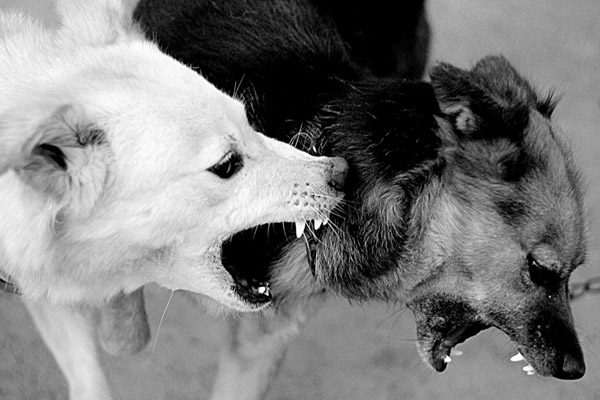Dogs can display aggressive behavior for a number of reasons. Knowing what your dog’s triggers are, as well as exposing them other dogs and individuals, will help curb their aggressive behavior. Aggressive behavior is not permanent and there are many methods and approaches to change and calm your dog’s aggressive behavior.
Preventing Aggression
Exercise your dog. Many dogs that demonstrate aggressive behavior benefit from extensive exercise regimens. The more energy your dog burns the better their state of mind and the less likely they are to exhibit aggression.[1]
- Take your dog for regular daily walks at least twice a day.
- Take your dog to the park to let them burn off excess energy.
Socialize your dog. Socializing your dog as early as possible will help them get used to encounters and interactions with both humans and other dogs. Take your dog to a dog park or create one on one play dates with other dogs to give your dog the social interaction it needs.[2]
- Consult your vet for recommendations for enrolling your dog in a socialization class.
Enroll your dog in behavioral courses. Aggression training camps can help deal with past traumatic experiences as well as provide both you and your dog with tools for dealing with aggressive behavior. Consult your vet for aggression training camp or behavioral class recommendations.
Know your dog’s triggers. Knowing what your dogs triggers are will help you avoid aggressive behavior and address it appropriately. Consult your breeder or shelter about your dog’s history to see if their aggression is learned or caused by trauma. Check the humane society to learn more about the causes and types of aggressive behavior to better understand what your dog’s triggers might be.[3]
- Bring your dog’s triggers to the attention of your vet to see if their behavior can be treated with medication.
- Make your dog’s triggers known to any trainer should you enroll in a aggression training camp or behavioral course.
Surrender your dog to their breeder or shelter. If you do not have the time, money, or resources to deal with and prevent your dog’s aggression you might consider surrendering you dog back to their breeder or shelter. Be honest about your concerns and the dog’s behavior so that they have the possibility of being re-homed to another owner who may be able to deal with their aggressive behavior.[4]
- Many shelters have a euthanasia policy in place for aggressive animals. Check with your shelter to discuss their aggressive animal policy.[5]
Dealing with Dog to Dog Aggression
Be calm and decisive. Dogs are sensitive to the moods of others, especially when they are in a state of aggression. The more calm you are when other dogs are approaching the less likely your dog will be to exhibit aggressive behavior.[6]
- Avoid tensing up the leash, forcing your dog to move quickly, or raising your voice if you anticipate a aggressive outburst. Instead, calmly lead your dog away from approaching dogs or if they are already displaying aggressive behavior.[7]
- Remember, the calmer you are the calmer your dog will be.
Create space. If you see another dog approaching, move to the other side of the road, walk to another side of the park, or take a safe distance and wait for the dog to pass. Creating space between your dog and the other dog will help you avoid any aggressive interaction.[8]
- Try using a blockade, like a car or tree, when another dog is approaching.
- Avoid pulling back on the leash when pulling your dog away from other dogs. Instead, pull your dog to the side and calmly lead them away.
Desensitize your dog to other dogs. The more frequently and consistently your dog interacts with other dogs the less likely they are to display aggressive behavior. Scheduling regular play dates with other dogs, walking calmly by other dogs, and have brief encounters with dogs at the dog park with help desensitize your dog.[9]
- Keep a long distance when first desensitizing your dog to other dogs. Once they seem comfortable continue approaching at a steady rate and stop and wait once their aggression is triggered again.[10]
Dealing with Dog to Human Aggression
Act calmly and quickly. Both dogs and people can be sensitive to the others moods. If you sense a potential outburst, or if your dog is already displaying aggressive behavior, stay calm and respond quickly. Restrain your dog on their leash or grab their collar and redirect them if they start displaying aggressive behavior.[11]
- Ask the individual to slowly back away and re-approach once your dog has calmed down.
Practicing blocking. Standing in front of your dog and blocking them from approaching others will keep their aggression at bay. Your dog’s line of vision will also be blocked, which may relieve them of their trigger entirely. Remember, you know your dog better than anyone else so it is your responsibility to mediate for them.[12]
- If you have enrolled in behavioral classes use some commands or directives to relive your dog of tension.
Slowly introduce your dog to new people. Many dogs are aggressive toward new people. Introducing them slowly will help your dog gradually become used to their presence and curb aggressive behavior. If you are trying to introduce your dog to someone specifically set up regular play dates where your dog can continually get used to the individual.
- Have the individual slowly extend the back of their hand and offer it to your dog to smell. This will help them become familiar with the individual and will allow for them to approach your dog.
Sources:
- https://www.cesarsway.com/dog-behavior/aggression/understanding-aggression
- ↑ http://www.paw-rescue.org/PAW/PETTIPS/DogTip_AggressionToApproachingDogsAndPeople.php
- ↑ https://www.animalhumanesociety.org/training/reasons-aggression-dogs
- ↑ https://www.animalhumanesociety.org/training/reasons-aggression-dogs
- ↑ https://www.animalhumanesociety.org/training/reasons-aggression-dogs
- ↑ http://shibashake.com/dog/dog-to-dog-aggression
- ↑ http://shibashake.com/dog/dog-to-dog-aggression
- ↑ http://shibashake.com/dog/dog-to-dog-aggression
- ↑ http://shibashake.com/dog/dog-to-dog-aggression
- ↑ http://www.paw-rescue.org/PAW/PETTIPS/DogTip_AggressionToApproachingDogsAndPeople.php
- ↑ http://shibashake.com/dog/dog-to-dog-aggression
- ↑ http://shibashake.com/dog/dog-to-dog-aggression

